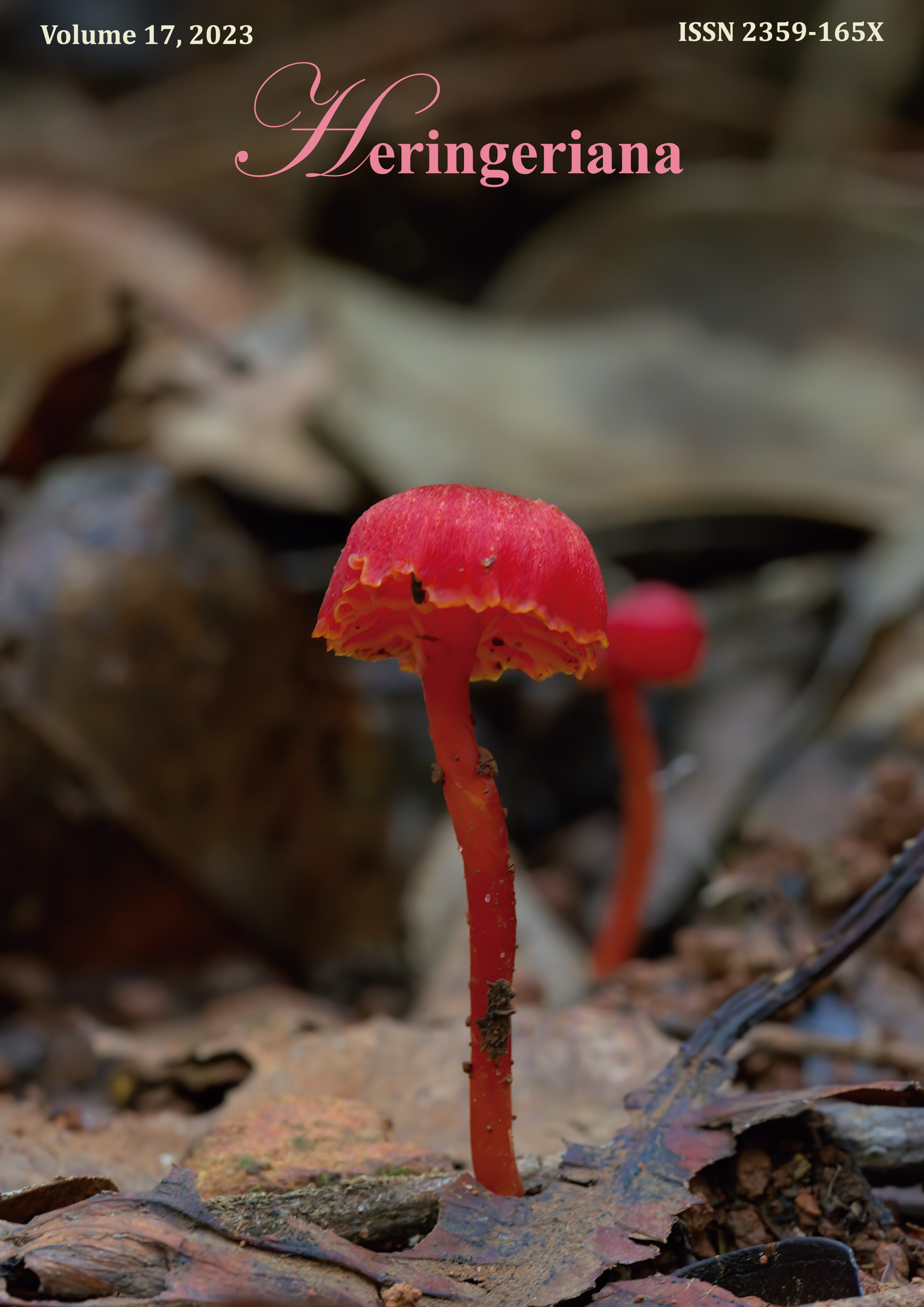Oxybelis aeneus (Wagler 1824): new record of predation and updated diet list
DOI:
https://doi.org/10.17648/heringeriana.v17i1.918024References
Aguiar, L.F.S. & Di-Bernardo, M. (2004) Diet and feeding behavior of Helicops infrataeniatus (Serpentes: Colubridae: Xenodontinae) in southern Brazil. Studies on the Neotropical Fauna and Environment 39: 7-14. https://doi.org/10.1080/01650520412331270927.
Almeida, G.V., Silva, G.L., Campos, T.F., Muniz, S.L. & Santos, E.M. (2009) Predação do lagarto Tropidurus cocorobensis pela serpente Oxybelis aeneus. Boletim do Museu de Biologia Mello Leitão 25: 83-86.
Ávila-Pires, T.C.S. (1995) Lizards of Brazilian Amazonian (Reptilia: Squamata). Zoologische verhandelingen 299: 1-706.
Barquero, M.D. (2018) Oxybelis aeneus: aggressive interactions with the clay-colored trush (Turdus grayi). Herpetological Bulletin 143: 43. Available at: https://www.thebhs.org/publications/the-herpetological-bulletin/issue-number-143-spring-2018/1819-12-i-oxybelis-aeneus-i-aggressive-interactions-with-the-clay-colored-trush-i-turdus-grayi-i (accessed: 1 June 2023).
Beebe, W. (1946) Field notes on the snakes of Kartabo, British Guiana, and Caripito, Venezuela. Zoologica 31: 11-52. http://dx.doi.org/10.29215/pecen.v2i1.587
Campos, F.S., Lage, A.R. & Lourenço-de-Moraes, R. (2022) Predation of Gymnodactylus darwinii (Squamata Phyllodactylidae) by Oxybelis aeneus (Squamata Colubridae) in Morro de São Paulo (Tinharé Island), Northeastern Brazil. Herpetology Notes 15: 97-99. Available at: https://www.biotaxa.org/hn/article/view/68084 (accessed: 1 June 2023).
Carvalho, C.B., Freitas, E.B., Faria, R.G., Batista, R.C., Batista, C.C., Coelho, W.A. & Bocchiglieri, A. (2008) História natural de Leptodactylus mystacinus e Leptodactylus fuscus (Anura: Leptodactylidae) no Cerrado do Brasil Central. Biota Neotropica 8: 105-115. https://doi.org/10.1590/S1676-06032008000300010.
Censky, E.J. & McCoy, C.J. (1988) Female reproductive cycles of five species of snakes (Reptilia: Colubridae) from the Yucatan Peninsula, Mexico. Biotropica 20: 326-333. https://doi.org/10.2307/2388323.
Costa, F.R.F., Pezeta, Y.F., Crozariol, M.A., de Oliveira, T.P., Henderson, R.W., & Gonzalez, R.C. (2022) A review of the diet of Oxybelis aeneus group (Squamata: Colubridae) including two new prey records from north-eastern Brazil. Herpetology Notes 15: 785-795. Available at: https://www.biotaxa.org/hn/article/view/73820 (accessed: 1 June 2023).
Cunha, O.R. & Nascimento, F.P. (1978). Ofídios da Amazônia. X - As cobras da região leste do Pará. Belém. Museu Paraense Emílio Goeldi, 218 p.
Cunha, O.R. & Nascimento, F.P. (1993). Ofídios da Amazônia. As cobras da região Leste do Pará. Boletim do Museu Paraense Emílio Goeldi: série zoologia, 9: 1-191.
França, F.G.R. & Araújo, A.F.B. (2007) Are there co-occurrence patterns that structure snake communities in Central Brazil? Brazilian Journal of Biology 67: 33-40. https://doi.org/10.1590/S1519-69842007000100005.
França, F.G.R., Mesquita, D.O., Nogueira, C.C. & Araújo, A.F.B. (2008) Phylogeny and ecology determine morphological structure in a snake assemblage in the Central Brazilian Cerrado. Copeia 2008: 23-38. https://doi.org/10.1643/CH-05-034.
Franzini, L.D., Pedro, C.K.B., Cavalcanti, L.B.Q. & Mesquita, D.O. (2018) Predation of Hemidactylus mabouia (Sauria: Gekkonidae) by a vine snake Oxybelis aeneus (Serpentes: Colubridae) in an Atlantic Forest fragment, northeastern Brazil. Pesquisa e Ensino em Ciências Exatas e da Natureza 2: 67-70. http://dx.doi.org/10.29215/pecen.v2i1.587
Goldberg, S.R. & Bursey, C.R. (2001) Hypsiglena torquata (Night snake) and Oxybelis aeneus (Brown vine snake). Endoparasites. Herpetological Review 32: 263.
Jadin, R.C., Blair, C., Jowers, M.J., Carmona, A., & Murphy, J.C. (2019) Hiding in the lianas of the tree of life: molecular phylogenetics and species delimitation reveal considerable cryptic diversity of New World Vine Snakes. Molecular Phylogenetics and Evolution 134: 61-65. https://doi.org/10.1016/j.ympev.2019.01.022
Jadin, R.C., Blair, C., Orlofske, S.A., Jowers, M.J., Rivas, G.A., Vitt, L.J., ... & Murphy, J. C. (2020) Not withering on the evolutionary vine: systematic revision of the Brown Vine Snake (Reptilia: Squamata: Oxybelis) from its northern distribution. Organisms Diversity and Evolution 20: 723-746. https://doi.org/10.1007/s13127-020-00461-0.
Jadin, R.C., Jowers, M.J., Orlofske, S.A., Duellman, W.E., Blair, C., & Murphy, J.C. (2021) A new vine snake (Reptilia, Colubridae, Oxybelis) from Peru and redescription of O. acuminatus. Evolutionary Systematics 5: 1-12. https://doi.org/10.3897/evolsyst.5.60626
Keiser Jr., E.D. (1982) Oxybelis aeneus (Wagler). Catalogue of American Amphibians and Reptiles 305: 1-4.
Martins, M. & Oliveira, M.E. (1998) Natural history of snakes in forests of the Manaus region, Central Amazonia, Brazil. Herpetological Natural History 6: 78-150.
Mesquita, P.C., Passos, D.C., Borges-Nojosa, D.M. & Cechin, S. Z. (2013) Ecologia e história natural das serpentes de uma área de Caatinga no nordeste brasileiro. Papéis Avulsos de Zoologia 53: 99-113. https://doi.org/10.1590/S0031-10492013000800001.
Mesquita, P.C.M.D., Borges-Nojosa, D.M., Passos, D.C. & Bezerra, C.H. (2012) Activity patterns of the Brown Vine snake Oxybelis aeneus (Wagler, 1824) (Serpentes, Colubridae) in the Brazilian semiarid. Animal Biology 62: 289-299.
https://doi.org/10.1163/157075611X618228.
Nogueira, C.C., Argôlo, A.J., Arzamendia, V., Azevedo, J.A., Barbo, F.E., Bérnils, R.S., ..., & Martins, M. (2019): Atlas of Brazilian snakes: verified point-locality maps to mitigate the Wallacean shortfall in a megadiverse snake fauna. South American Journal of Herpetology 14: 1-274. https://doi.org/10.2994/SAJH-D-19-00120.1
Oliveira, C.R., Brasileiro, A.C. & Mascarenhas, W. (2020) Oxybelis aeneus (Brown Vine Snake). Diet. Herpetological Review 51: 876.
Oliveira, M., Gottschalk, M.S., Loebmann, D., Santos, M.B., Miranda, S., Rosa, C. & Tozetti, A.M. (2015) Diet composition and niche overlap in two sympatric species of Physalaemus (Anura, Leptodactylidae, Leiuperinae) in coastal subtemperate wetlands. Herpetology Notes 8: 173-177.
Oliveira-Souza, A.E., Pena, A.S., Costa-Anaissi, J.S., Melo, F.S., Pinheiro, R.T. & Costa-Campos, C.E. (2021) Predation by the vinesnake Oxybelis aeneus (Squamata, Colubridae) on the gecko Gonatodes humeralis (Squamata, Sphaerodactylidae) in a Brazilian Amazon forest fragment, with a compilation of its prey. Herpetology Notes 14: 1111-1115.
Queiroz, L.P.D. (2009) Leguminosas da caatinga. Universidade Estadual de Feira de Santana.
Recoder, R., Junior, M.T., Camacho, A. & Rodrigues, M.T. (2012) Natural history of the tropical gecko Phyllopezus pollicaris (Squamata, Phyllodactylidae) from a sandstone outcrop in Central Brazil. Herpetology Notes 5: 49-58.
Santos, R.A., Santana, D.O., Caldas, F.L.S. & Faria, R.G. (2012) Tropidurus hygomi (Reinhardt’s Lava Lizard). Predation. Herpetological Review 43: 490-491.
Sawaya, R.J., Marques, O.A.V. & Martins, M. (2008) Composição e história natural das serpentes de cerrado de Itirapina, São Paulo, sudeste do Brasil. Biota Neotropica 8: 127‑148. https://doi.org/10.1590/S1676-06032008000200015
Shine R. (ed.) (1995) Australian Snakes: A Natural History. Ithaca, Cornell University Press.
Silva N.V.N., Mello, A.V.A., Oliveira, P.M.D.A., de Andrade Lima, J.H., de Castro Ribeiro, L.R. & Simões, P.I. (2021) Predation of Ameivula ocellifera (Squamata, Teiidae) by Oxybelis aeneus (Squamata, Colubridae), in the Caatinga, Northeastern Brazil, including a list of saurophagy by this snake. Heringeriana 15: 96-100. https://doi.org/17648/heringeriana.v15i1.917960.
Silva, M.V., Souza, M.B. & Bernarde, P.S. (2010) Riqueza e dieta de serpentes do Estado do Acre, Brasil. Revista Brasileira de Zoociências 12: 165-176.
Vitt, L.J. & Vangilder, L.D. (1983) Ecology of a snake community in Northeastern Brazil. Amphibia-Reptilia 4: 273-296. https://doi.org/10.1163/156853883X00148
Downloads
Published
How to Cite
Issue
Section
License
Copyright (c) 2023 Cicero Ricardo Oliveira, Alcéster Diego Coelho-Lima, Ana Carolina Brasileiro, Lyse Panelli de Castro Meira

This work is licensed under a Creative Commons Attribution 4.0 International License.
By submitting, the authors declare that they have not submitted the work to another journal and agree to have their article published under a Creative Commons Attribution 4.0 International BY License (CC BY 4.0), which means that authors retain ownership of the copyright but anyone can use the published content provided the original authors and source are cited. The scientific, orthographic and grammatical content is the full responsibility of the authors.








